Olympus E-5 vs E-600
The Olympus E-5 and the Olympus E-600 are two digital cameras that were officially introduced, respectively, in September 2010 and August 2009. Both are DSLR (Digital Single Lens Reflex) cameras that are equipped with a Four Thirds sensor. Both cameras offer a resolution of 12.2 megapixels.
Below is an overview of the main specs of the two cameras as a starting point for the comparison.

Check E-5 offers at
ebay.com

Check E-600 offers at
ebay.com
Going beyond this snapshot of core features and characteristics, what are the differences between the Olympus E-5 and the Olympus E-600? Which one should you buy? Read on to find out how these two cameras compare with respect to their body size, their imaging sensors, their shooting features, their input-output connections, and their reception by expert reviewers.
Body comparison
The physical size and weight of the Olympus E-5 and the Olympus E-600 are illustrated in the side-by-side display below. The two cameras are presented according to their relative size. Three successive views from the front, the top, and the rear are shown. All size dimensions are rounded to the nearest millimeter.
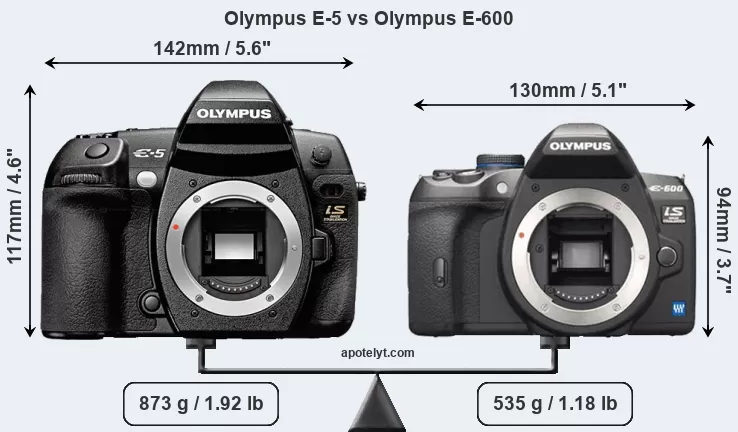
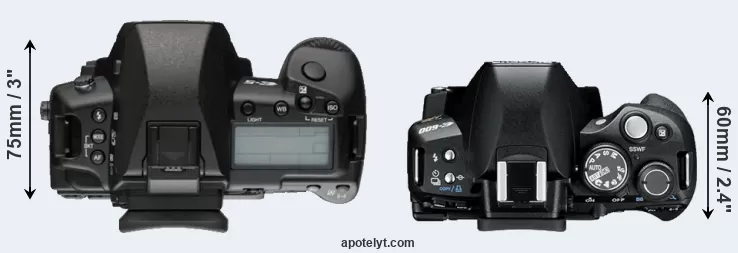
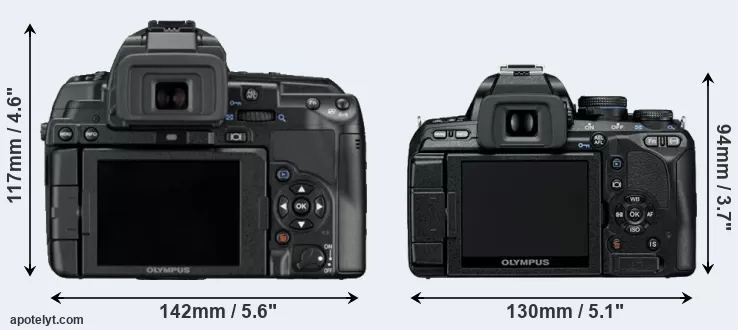
If the front view area (width x height) of the cameras is taken as an aggregate measure of their size, the Olympus E-600 is notably smaller (26 percent) than the Olympus E-5. Moreover, the E-600 is substantially lighter (39 percent) than the E-5. It is worth mentioning in this context that the E-5 is splash and dust resistant, while the E-600 does not feature any corresponding weather-sealing.
The above size and weight comparisons are to some extent incomplete since they do not consider the interchangeable lenses that both of these cameras require. In this particular case, both cameras feature the same lens mount, so that they can use the same lenses. You can compare the optics available in the Four Thirds Lens Catalog.
Concerning battery life, the E-5 gets 750 shots out of its Olympus BLM-5 battery, while the E-600 can take 500 images on a single charge of its Olympus BLS-1 power pack.
The table below summarizes the key physical specs of the two cameras alongside a broader set of comparators. If you would like to visualize and compare a different camera combination, you can navigate to the CAM-parator app and make your selection from a broad list of cameras there.

| Camera Model |
Camera Width |
Camera Height |
Camera Depth |
Camera Weight |
Battery Life |
Weather Sealing |
Camera Launch |
Launch Price |
Street Price |
||
|---|---|---|---|---|---|---|---|---|---|---|---|
| 1. | Olympus E-5 | 142 mm | 117 mm | 75 mm | 873 g | 750 | Y | Sep 2010 | US$ 1 699 | ebay.com | |
| 2. | Olympus E-600 | 130 mm | 94 mm | 60 mm | 535 g | 500 | n | Aug 2009 | US$ 449 | ebay.com | |
| 3. | Olympus E-1 | 141 mm | 104 mm | 81 mm | 738 g | 750 | Y | Jun 2003 | US$ 1 699 | ebay.com | |
| 4. | Olympus E-3 | 142 mm | 116 mm | 75 mm | 876 g | 750 | Y | Oct 2007 | US$ 1 699 | ebay.com | |
| 5. | Olympus E-30 | 142 mm | 108 mm | 75 mm | 701 g | 750 | n | Nov 2008 | US$ 1 299 | ebay.com | |
| 6. | Olympus E-420 | 130 mm | 91 mm | 53 mm | 440 g | 500 | n | Mar 2008 | US$ 599 | ebay.com | |
| 7. | Olympus E-450 | 130 mm | 91 mm | 53 mm | 440 g | 500 | n | Mar 2009 | US$ 499 | ebay.com | |
| 8. | Olympus E-510 | 136 mm | 92 mm | 68 mm | 538 g | 750 | n | Mar 2007 | US$ 799 | ebay.com | |
| 9. | Olympus E-520 | 136 mm | 92 mm | 68 mm | 535 g | 750 | n | May 2008 | US$ 699 | ebay.com | |
| 10. | Olympus E-620 | 130 mm | 94 mm | 60 mm | 521 g | 500 | n | Feb 2009 | US$ 699 | ebay.com | |
| 11. | Olympus E-P1 | 121 mm | 70 mm | 36 mm | 355 g | 300 | n | Jun 2009 | US$ 799 | ebay.com | |
| 12. | Olympus E-P2 | 121 mm | 70 mm | 36 mm | 355 g | 300 | n | Nov 2009 | US$ 799 | ebay.com | |
| 13. | Olympus E-PL1 | 115 mm | 72 mm | 42 mm | 334 g | 290 | n | Feb 2010 | US$ 599 | ebay.com | |
| Note: Measurements and pricing do not include easily detachable parts, such as add-on or interchangeable lenses or optional viewfinders. | |||||||||||
Any camera decision will naturally be influenced heavily by the price. The listed launch prices provide an indication of the market segment that the manufacturer of the cameras have been targeting. The E-600 was launched at a markedly lower price (by 74 percent) than the E-5, which puts it into a different market segment. Usually, retail prices stay at first close to the launch price, but after several months, discounts become available. Later in the product cycle and, in particular, when the replacement model is about to appear, further discounting and stock clearance sales often push the camera price considerably down.
Sensor comparison
The size of the imaging sensor is a crucial determinant of image quality. A large sensor will generally have larger individual pixels that offer better low-light sensitivity, provide wider dynamic range, and have richer color-depth than smaller pixels in a sensor of the same technological generation. Furthermore, a large sensor camera will give the photographer more possibilities to use shallow depth-of-field in order to isolate a subject from the background. On the downside, larger sensors tend to be associated with larger, more expensive camera bodies and lenses.
Both cameras under consideration feature a Four Thirds sensor and have a format factor (sometimes also referred to as "crop factor") of 2.0. Within the spectrum of camera sensors, this places the review cameras among the medium-sized sensor cameras that aim to strike a balance between image quality and portability. Both cameras feature a native aspect ratio (sensor width to sensor height) of 4:3.
In terms of chip-set technology, the E-5 uses a more advanced image processing engine (TruePic V+) than the E-600 (TruePic III+), with benefits for noise reduction, color accuracy, and processing speed.
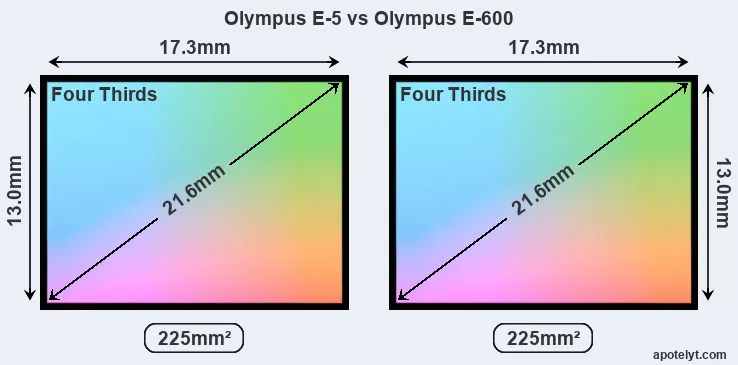
The two cameras under review do not only share the same sensor size, but also offer an identical resolution of 12.2 megapixels. This similarity in sensor specs implies that both the E-5 and the E-600 have the same pixel density, as well as the same pixel size. It should, however, be noted that the E-5 is a somewhat more recent model (by 1 year) than the E-600, and its sensor might have benefitted from technological advances during this time.
The Olympus E-5 has a native sensitivity range from ISO 100 to ISO 6400. The corresponding ISO settings for the Olympus E-600 are ISO 100 to ISO 3200 (no boost).
Technology-wise, both cameras are equipped with CMOS (Complementary Metal–Oxide–Semiconductor) sensors. Both cameras use a Bayer filter for capturing RGB colors on a square grid of photosensors. This arrangement is found in most digital cameras.
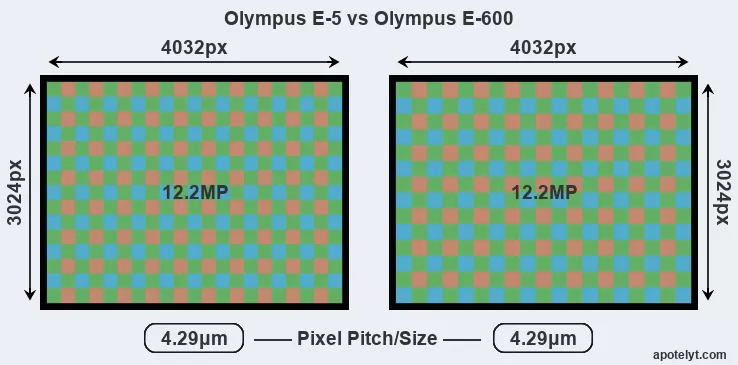
Since 2007, DXO Mark has published sensor performance measurements that have been derived using a consistent methodology. This service is based on lab testing and assigns an overall score to each camera sensor, as well as ratings for dynamic range ("DXO Landscape"), color depth ("DXO Portrait"), and low-light sensitivity ("DXO Sports"). The Overall DXO ratings for the two cameras under consideration are close, suggesting that they provide similar imaging performance. The table below summarizes the physical sensor characteristics and sensor quality findings and compares them across a set of similar cameras.

| Camera Model |
Sensor Class |
Resolution (MP) |
Horiz. Pixels |
Vert. Pixels |
Video Format |
DXO Portrait |
DXO Landscape |
DXO Sports |
DXO Overall |
||
|---|---|---|---|---|---|---|---|---|---|---|---|
| 1. | Olympus E-5 | Four Thirds | 12.2 | 4032 | 3024 | 720/30p | 21.6 | 10.5 | 519 | 56 | |
| 2. | Olympus E-600 | Four Thirds | 12.2 | 4032 | 3024 | none | 21.5 | 10.3 | 541 | 55 | |
| 3. | Olympus E-1 | Four Thirds | 4.9 | 2560 | 1920 | none | 20.0 | 9.7 | -145 | 44 | |
| 4. | Olympus E-3 | Four Thirds | 10.0 | 3648 | 2736 | none | 21.6 | 10.5 | 571 | 56 | |
| 5. | Olympus E-30 | Four Thirds | 12.2 | 4032 | 3024 | none | 21.3 | 10.4 | 530 | 55 | |
| 6. | Olympus E-420 | Four Thirds | 10.0 | 3648 | 2736 | none | 21.5 | 10.4 | 527 | 56 | |
| 7. | Olympus E-450 | Four Thirds | 10.0 | 3648 | 2736 | none | 21.5 | 10.5 | 512 | 56 | |
| 8. | Olympus E-510 | Four Thirds | 10.0 | 3648 | 2736 | none | 21.2 | 10.0 | 442 | 52 | |
| 9. | Olympus E-520 | Four Thirds | 10.0 | 3648 | 2736 | none | 21.4 | 10.4 | 548 | 55 | |
| 10. | Olympus E-620 | Four Thirds | 12.2 | 4032 | 3024 | none | 21.3 | 10.3 | 536 | 55 | |
| 11. | Olympus E-P1 | Four Thirds | 12.2 | 4032 | 3024 | 720/30p | 21.4 | 10.4 | 536 | 55 | |
| 12. | Olympus E-P2 | Four Thirds | 12.2 | 4032 | 3024 | 720/30p | 21.5 | 10.4 | 505 | 56 | |
| 13. | Olympus E-PL1 | Four Thirds | 12.2 | 4032 | 3024 | 720/30p | 21.5 | 10.1 | 487 | 54 | |
| Note: DXO values in italics represent estimates based on sensor size and age. | |||||||||||
Many modern cameras are not only capable of taking still images, but also of capturing video footage. The E-5 indeed provides movie recording capabilities, while the E-600 does not. The highest resolution format that the E-5 can use is 720/30p.
Feature comparison
Apart from body and sensor, cameras can and do differ across a variety of features. The E-5 and the E-600 are similar in the sense that both have an optical viewfinder. The latter is useful for getting a clear image for framing even in brightly lit environments. The viewfinder in the E-5 offers a wider field of view (100%) than the one in the E-600 (95%), so that a larger proportion of the captured image is visible in the finder. In addition, the viewfinder of the E-5 has a higher magnification (0.58x vs 0.48x), so that the size of the image transmitted appears closer to the size seen with the naked human eye. The adjacent table lists some of the other core features of the Olympus E-5 and Olympus E-600 along with similar information for a selection of comparators.

| Camera Model |
Viewfinder (Type or 000 dots) |
Control Panel (yes/no) |
LCD Specifications (inch/000 dots) |
LCD Attach- ment |
Touch Screen (yes/no) |
Max Shutter Speed * |
Max Shutter Flaps * |
Built-in Flash (yes/no) |
Built-in Image Stab |
||
|---|---|---|---|---|---|---|---|---|---|---|---|
| 1. | Olympus E-5 | optical | Y | 3.0 / 920 | swivel | n | 1/8000s | 5.0/s | Y | Y | |
| 2. | Olympus E-600 | optical | n | 2.7 / 230 | swivel | n | 1/4000s | 4.0/s | Y | Y | |
| 3. | Olympus E-1 | optical | Y | 1.8 / 134 | fixed | n | 1/4000s | 3.0/s | n | n | |
| 4. | Olympus E-3 | optical | Y | 2.5 / 230 | swivel | n | 1/8000s | 5.0/s | Y | Y | |
| 5. | Olympus E-30 | optical | Y | 2.7 / 230 | swivel | n | 1/8000s | 5.0/s | Y | Y | |
| 6. | Olympus E-420 | optical | n | 2.7 / 215 | fixed | n | 1/4000s | 3.5/s | Y | n | |
| 7. | Olympus E-450 | optical | n | 2.7 / 215 | fixed | n | 1/4000s | 3.5/s | Y | n | |
| 8. | Olympus E-510 | optical | n | 2.5 / 215 | fixed | n | 1/4000s | 3.0/s | Y | Y | |
| 9. | Olympus E-520 | optical | n | 2.7 / 215 | fixed | n | 1/4000s | 3.5/s | Y | Y | |
| 10. | Olympus E-620 | optical | n | 2.7 / 230 | swivel | n | 1/4000s | 4.0/s | Y | Y | |
| 11. | Olympus E-P1 | none | n | 3.0 / 230 | fixed | n | 1/4000s | 3.0/s | n | Y | |
| 12. | Olympus E-P2 | optional | n | 3.0 / 230 | fixed | n | 1/4000s | 3.0/s | n | Y | |
| 13. | Olympus E-PL1 | optional | n | 2.7 / 230 | fixed | n | 1/2000s | 3.0/s | Y | Y | |
| Note: *) Information refers to the mechanical shutter, unless the camera only has an electronic one. | |||||||||||
One feature that is present on the E-5, but is missing on the E-600 is a top-level LCD. While being, of course, smaller than the rear screen, the control panel conveys some of the essential shooting information and can be convenient for quick and easy settings verification.
Both cameras have an articulated rear screen that can be turned to be front-facing. This feature will be particularly appreciated by vloggers and photographers who are interested in taking selfies.Concerning the storage of imaging data, both the E-5 and the E-600 write their files to Compact Flash or xD Picture cards. Both cameras feature dual card slots, which can be very useful in case a memory card fails.
Connectivity comparison
For some imaging applications, the extent to which a camera can communicate with its environment can be an important aspect in the camera decision process. The table below provides an overview of the connectivity of the Olympus E-5 and Olympus E-600 and, in particular, the interfaces the cameras (and selected comparators) provide for accessory control and data transfer.

| Camera Model |
Hotshoe Port |
Internal Mic / Speaker |
Microphone Port |
Headphone Port |
HDMI Port |
USB Port |
WiFi Support |
NFC Support |
Bluetooth Support |
||
|---|---|---|---|---|---|---|---|---|---|---|---|
| 1. | Olympus E-5 | Y | stereo / - | - | - | mini | 2.0 | - | - | - | |
| 2. | Olympus E-600 | Y | - / - | - | - | - | 2.0 | - | - | - | |
| 3. | Olympus E-1 | Y | - / - | - | - | - | 2.0 | - | - | - | |
| 4. | Olympus E-3 | Y | - / - | - | - | - | 2.0 | - | - | - | |
| 5. | Olympus E-30 | Y | - / - | - | - | - | 2.0 | - | - | - | |
| 6. | Olympus E-420 | Y | - / - | - | - | - | 2.0 | - | - | - | |
| 7. | Olympus E-450 | Y | - / - | - | - | - | 2.0 | - | - | - | |
| 8. | Olympus E-510 | Y | - / - | - | - | - | 2.0 | - | - | - | |
| 9. | Olympus E-520 | Y | - / - | - | - | - | 2.0 | - | - | - | |
| 10. | Olympus E-620 | Y | - / - | - | - | - | 2.0 | - | - | - | |
| 11. | Olympus E-P1 | Y | stereo / - | - | - | mini | 2.0 | - | - | - | |
| 12. | Olympus E-P2 | Y | stereo / - | - | - | mini | 2.0 | - | - | - | |
| 13. | Olympus E-PL1 | Y | stereo / - | - | - | mini | 2.0 | - | - | - |
Studio photographers will appreciate that the Olympus E-5 (unlike the E-600) features a PC Sync socket, so that professional strobe lights can be controlled by the camera.
Both the E-5 and the E-600 have been discontinued, but can regularly be found used on ebay. Neither of the two has a direct successor, so they represent the end of the respective camera lines from Olympus. Further information on the features and operation of the E-5 and E-600 can be found, respectively, in the Olympus E-5 Manual (free pdf) or the online Olympus E-600 Manual.
Review summary
So how do things add up? Is there a clear favorite between the Olympus E-5 and the Olympus E-600? Which camera is better? A synthesis of the relative strong points of each of the models is listed below.
Arguments in favor of the Olympus E-5:
- Better jpgs: Has a more modern image processing engine (TruePic V+ vs TruePic III+).
- Broader imaging potential: Can record not only still images but also 720/30p movies.
- More complete view: Has a viewfinder with a larger field of view (100% vs 95%).
- Larger viewfinder image: Features a viewfinder with a higher magnification (0.58x vs 0.48x).
- Easier setting verification: Features an LCD display on top to control shooting parameters.
- Larger screen: Has a bigger rear LCD (3.0" vs 2.7") for image review and settings control.
- More detailed LCD: Has a higher resolution rear screen (920k vs 230k dots).
- Faster shutter: Has higher mechanical shutter speed (1/8000s vs 1/4000s) to freeze action.
- Faster burst: Shoots at higher frequency (5 vs 4 flaps/sec) to capture the decisive moment.
- Longer lasting: Can take more shots (750 versus 500) on a single battery charge.
- Better sealing: Is weather sealed to enable shooting in dusty or wet environments.
- Better studio light control: Has a PC Sync socket to connect to professional strobe lights.
- More modern: Is somewhat more recent (announced 1 year after the E-600).
Advantages of the Olympus E-600:
- More compact: Is smaller (130x94mm vs 142x117mm) and will fit more readily into a bag.
- Less heavy: Has a lower weight (by 338g or 39 percent) and is thus easier to take along.
- More affordable: Was introduced into a lower priced category (74 percent cheaper at launch).
- More heavily discounted: Has been on the market for longer (launched in August 2009).
If the count of individual advantages (bullet points above) is taken as a guide, the E-5 is the clear winner of the match-up (13 : 4 points). However, the pertinence of the various camera strengths will differ across photographers, so that you might want to weigh individual camera traits according to their importance for your own imaging needs before making a camera decision. A professional wedding photographer will view the differences between cameras in a way that diverges from the perspective of a travel photog, and a person interested in cityscapes has distinct needs from a macro shooter. Hence, the decision which camera is best and worth buying is often a very personal one.
How about other alternatives? Do the specifications of the Olympus E-5 and the Olympus E-600 place the cameras among the top in their class? Find out in the latest Best DSLR Camera listing whether the two cameras rank among the cream of the crop.
In any case, while the comparison of technical specifications can provide a useful overview of the capabilities of different cameras, it remains incomplete and does no justice, for example, to the way the E-5 or the E-600 perform in practice. User reviews that are available, for instance, at amazon can sometimes shed light on these issues, but such feedback is all too often partial, inconsistent, and inaccurate.
Expert reviews
This is why hands-on reviews by experts are important. The following table reports the overall ratings of the cameras as published by some of the major camera review sites (amateurphotographer [AP], cameralabs [CL], digitalcameraworld [DCW], dpreview [DPR], ephotozine [EPZ], photographyblog [PB]). As can be seen, the professional reviewers agree in many cases on the quality of different cameras, but sometimes their assessments diverge, reinforcing the earlier point that a camera decision is often a very personal choice.

| Camera Model |
AP score |
CL score |
DCW score |
DPR score |
EPZ score |
PB score |
Camera Launch |
Launch Price |
Street Price |
||
|---|---|---|---|---|---|---|---|---|---|---|---|
| 1. | Olympus E-5 | 4/5 | .. | .. | 75/100 | 4/5 | 4.5/5 | Sep 2010 | US$ 1 699 | ebay.com | |
| 2. | Olympus E-600 | .. | .. | .. | .. | .. | 4.5/5 | Aug 2009 | US$ 449 | ebay.com | |
| 3. | Olympus E-1 | .. | .. | .. | + | o | .. | Jun 2003 | US$ 1 699 | ebay.com | |
| 4. | Olympus E-3 | .. | 88/100 | .. | + + | o | 4/5 | Oct 2007 | US$ 1 699 | ebay.com | |
| 5. | Olympus E-30 | .. | .. | .. | 71/100 | 4.5/5 | 4/5 | Nov 2008 | US$ 1 299 | ebay.com | |
| 6. | Olympus E-420 | .. | 85/100 | .. | + + | 4/5 | 4.5/5 | Mar 2008 | US$ 599 | ebay.com | |
| 7. | Olympus E-450 | .. | .. | .. | .. | 4/5 | 4/5 | Mar 2009 | US$ 499 | ebay.com | |
| 8. | Olympus E-510 | .. | 89/100 | .. | + + | 3.5/5 | 4.5/5 | Mar 2007 | US$ 799 | ebay.com | |
| 9. | Olympus E-520 | .. | 87/100 | .. | + + | 4.5/5 | 4.5/5 | May 2008 | US$ 699 | ebay.com | |
| 10. | Olympus E-620 | 3/5 | 88/100 | .. | 72/100 | 4.5/5 | 5/5 | Feb 2009 | US$ 699 | ebay.com | |
| 11. | Olympus E-P1 | .. | + | .. | 66/100 | 4/5 | 4.5/5 | Jun 2009 | US$ 799 | ebay.com | |
| 12. | Olympus E-P2 | 3/5 | + | .. | 69/100 | 4/5 | 4.5/5 | Nov 2009 | US$ 799 | ebay.com | |
| 13. | Olympus E-PL1 | .. | 86/100 | .. | 69/100 | 4/5 | 4.5/5 | Feb 2010 | US$ 599 | ebay.com | |
| Note: (+ +) highly recommended; (+) recommended; (o) reviewed; (..) not available. | |||||||||||
The above review scores should be interpreted with care, though. The ratings are only valid when referring to cameras in the same category and of the same age. A score, therefore, has to be seen in close connection to the price and market introduction time of the camera, and comparing ratings of very distinct cameras or ones that are far apart in terms of their release date have little meaning. Also, kindly note that some of the listed sites have over time developped their review approaches and their reporting style.

Check E-5 offers at
ebay.com

Check E-600 offers at
ebay.com
Other camera comparisons
Did this review help to inform your camera decision process? If you would like to see a different side-by-side camera review, just use the search menu below. There is also a set of direct links to comparison reviews that other users of the CAM-parator app explored.
- Canon 200D vs Olympus E-600
- Canon D60 vs Olympus E-600
- Canon G5 X vs Olympus E-5
- Canon XTi vs Olympus E-600
- Leica S2 vs Olympus E-600
- Nikon 1 V1 vs Olympus E-5
- Nikon D1 vs Olympus E-5
- Nikon D7500 vs Olympus E-600
- Olympus E-30 vs Olympus E-5
- Olympus E-5 vs Pentax 645Z
- Olympus E-5 vs Sony RX100
- Olympus E-600 vs Sony RX100 V
Specifications: Olympus E-5 vs Olympus E-600
Below is a side-by-side comparison of the specs of the two cameras to facilitate a quick review of their differences and common features.
| Camera Model | Olympus E-5 | Olympus E-600 |
|---|---|---|
| Camera Type | Digital single lens reflex | Digital single lens reflex |
| Camera Lens | Four Thirds lenses | Four Thirds lenses |
| Launch Date | September 2010 | August 2009 |
| Launch Price | USD 1,699 | USD 449 |
| Sensor Specs | Olympus E-5 | Olympus E-600 |
| Sensor Technology | CMOS | CMOS |
| Sensor Format | Four Thirds Sensor | Four Thirds Sensor |
| Sensor Size | 17.3 x 13.0 mm | 17.3 x 13.0 mm |
| Sensor Area | 224.9 mm2 | 224.9 mm2 |
| Sensor Diagonal | 21.6 mm | 21.6 mm |
| Crop Factor | 2.0x | 2.0x |
| Sensor Resolution | 12.2 Megapixels | 12.2 Megapixels |
| Image Resolution | 4032 x 3024 pixels | 4032 x 3024 pixels |
| Pixel Pitch | 4.29 μm | 4.29 μm |
| Pixel Density | 5.42 MP/cm2 | 5.42 MP/cm2 |
| Moiré control | Anti-Alias filter | Anti-Alias filter |
| Movie Capability | 720/30p Video | no Video |
| ISO Setting | 100 - 6,400 ISO | 100 - 3,200 ISO |
| Image Processor | TruePic V+ | TruePic III+ |
| DXO Sensor Quality (score) | 56 | 55 |
| DXO Color Depth (bits) | 21.6 | 21.5 |
| DXO Dynamic Range (EV) | 10.5 | 10.3 |
| DXO Low Light (ISO) | 519 | 541 |
| Screen Specs | Olympus E-5 | Olympus E-600 |
| Viewfinder Type | Optical viewfinder | Optical viewfinder |
| Viewfinder Field of View | 100% | 95% |
| Viewfinder Magnification | 0.58x | 0.48x |
| Top-Level Screen | Control Panel | no Top Display |
| LCD Framing | Live View | Live View |
| Rear LCD Size | 3.0inch | 2.7inch |
| LCD Resolution | 920k dots | 230k dots |
| LCD Attachment | Swivel screen | Swivel screen |
| Shooting Specs | Olympus E-5 | Olympus E-600 |
| Focus System | Phase-detect AF | Phase-detect AF |
| Continuous Shooting | 5 shutter flaps/s | 4 shutter flaps/s |
| Image Stabilization | In-body stabilization | In-body stabilization |
| Fill Flash | Built-in Flash | Built-in Flash |
| Storage Medium | CF or XD cards | CF or XD cards |
| Single or Dual Card Slots | Dual card slots | Dual card slots |
| Connectivity Specs | Olympus E-5 | Olympus E-600 |
| External Flash | Hotshoe | Hotshoe |
| Studio Flash | PC Sync socket | no PC Sync |
| USB Connector | USB 2.0 | USB 2.0 |
| HDMI Port | mini HDMI | no HDMI |
| Wifi Support | no Wifi | no Wifi |
| Body Specs | Olympus E-5 | Olympus E-600 |
| Environmental Sealing | Weathersealed body | not weather sealed |
| Battery Type | Olympus BLM-5 | Olympus BLS-1 |
| Battery Life (CIPA) | 750 shots per charge | 500 shots per charge |
| Body Dimensions |
142 x 117 x 75 mm (5.6 x 4.6 x 3.0 in) |
130 x 94 x 60 mm (5.1 x 3.7 x 2.4 in) |
| Camera Weight | 873 g (30.8 oz) | 535 g (18.9 oz) |

Check E-5 offers at
ebay.com

Check E-600 offers at
ebay.com
Did you notice an error on this page? If so, please get in touch, so that we can correct the information.

